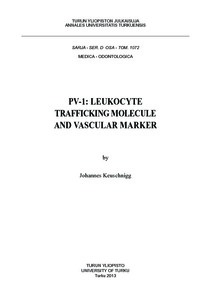PV-1: Leukocyte trafficking molecule and vascular marker
Keuschnigg, Johannes (2013-06-07)
PV-1: Leukocyte trafficking molecule and vascular marker
Keuschnigg, Johannes
(07.06.2013)
Annales Universitatis Turkuensis D 1072 Turun yliopisto
Julkaisun pysyvä osoite on:
https://urn.fi/URN:ISBN:978-951-29-5406-3
https://urn.fi/URN:ISBN:978-951-29-5406-3
Kuvaus
Siirretty Doriasta
ei tietoa saavutettavuudesta
ei tietoa saavutettavuudesta
Tiivistelmä
The distinction between lymphatic vessels and blood vessels is a crucial factor in
many studies in immunology, vascular biology and cancer biology. They both share
several characteristics and perform related, though different functions. They are
equally important for the performance of the human immune system with the
continuous recirculation of leukocytes from the tissues via lymphatics to the blood
vessels and back into the tissue presenting the link between both systems.
This study was undertaken to elucidate the differences in the gene expression between
primary blood- and lymphatic endothelial cells as well as the two immortalized cell
lines HMEC-1 (human microvascular endothelial cell line 1) and TIME (telomerase
immortalized microvascular endothelial cell line). Furthermore, we wanted to
investigate the mystery surrounding the identity of the antigen recognized by the
prototype blood vascular marker PAL-E. In the last step we wanted to study whether
the PAL-E antigen would be involved in the process of leukocyte migration from the
bloodstream into the surrounding tissue.
Our results clearly show that the gene expression in primary blood endothelial cells
(BEC), lymphatic endothelial cells (LEC) and the cell lines HMEC-1 and TIME is
plastic. Comparison of a large set of BEC- and LEC datasets allowed us to assemble a
catalog of new, stable BEC- or LEC specific markers, which we verified in
independent experiments. Additionally, several lines of evidence demonstrated that
PAL-E recognizes plasmalemma vesicle associated protein 1 (PV-1), which can form
complexes with vimentin and neuropilin-1. Finally, numerous in vitro and in vivo
experiments identify the first function of the protein PV-1 during leukocyte
trafficking, where it acts as regulatory molecule.
many studies in immunology, vascular biology and cancer biology. They both share
several characteristics and perform related, though different functions. They are
equally important for the performance of the human immune system with the
continuous recirculation of leukocytes from the tissues via lymphatics to the blood
vessels and back into the tissue presenting the link between both systems.
This study was undertaken to elucidate the differences in the gene expression between
primary blood- and lymphatic endothelial cells as well as the two immortalized cell
lines HMEC-1 (human microvascular endothelial cell line 1) and TIME (telomerase
immortalized microvascular endothelial cell line). Furthermore, we wanted to
investigate the mystery surrounding the identity of the antigen recognized by the
prototype blood vascular marker PAL-E. In the last step we wanted to study whether
the PAL-E antigen would be involved in the process of leukocyte migration from the
bloodstream into the surrounding tissue.
Our results clearly show that the gene expression in primary blood endothelial cells
(BEC), lymphatic endothelial cells (LEC) and the cell lines HMEC-1 and TIME is
plastic. Comparison of a large set of BEC- and LEC datasets allowed us to assemble a
catalog of new, stable BEC- or LEC specific markers, which we verified in
independent experiments. Additionally, several lines of evidence demonstrated that
PAL-E recognizes plasmalemma vesicle associated protein 1 (PV-1), which can form
complexes with vimentin and neuropilin-1. Finally, numerous in vitro and in vivo
experiments identify the first function of the protein PV-1 during leukocyte
trafficking, where it acts as regulatory molecule.
Kokoelmat
- Väitöskirjat [3022]
